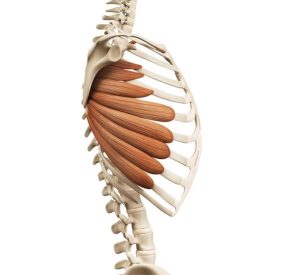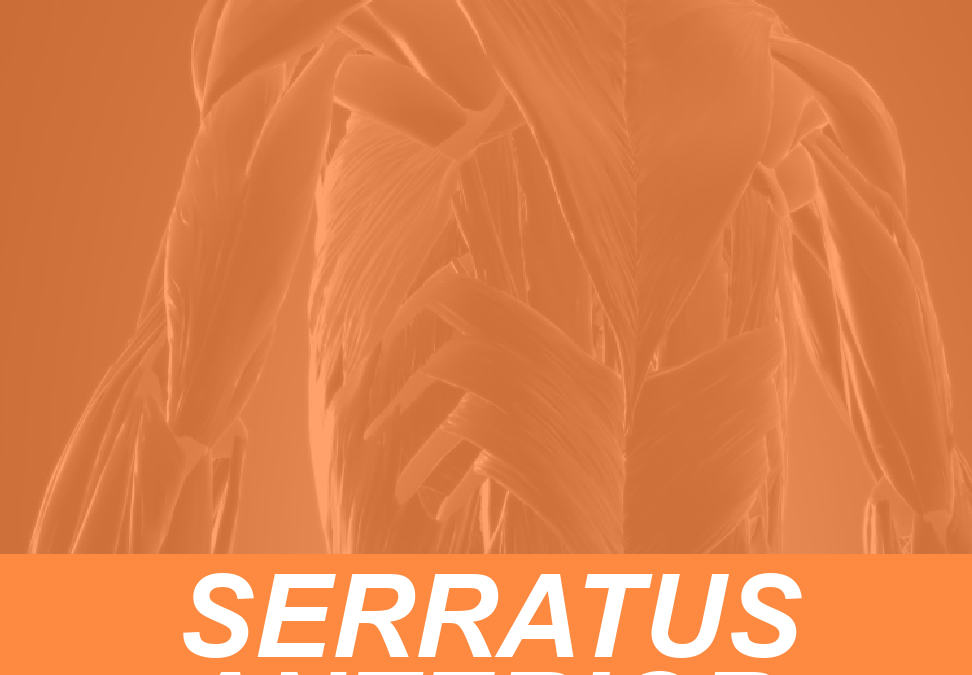Serratus anterior is often referred to as “the boxer’s muscle” because it is largely responsible for protraction of the scapula – the forward movement of the shoulder blade that takes place, like when someone throws a punch. But even if our clients never step in the boxing ring, this muscle is important for personal trainers to understand and train.
Where is the Serratus Anterior?
Serratus anterior gets its name from its serrated, or saw-tooth, appearance. The muscle fans across the lateral rib cage, originating from the 1st to 8th or 9th ribs and inserting at the anterior surface of the shoulder blade, or scapula. Lying deep under the pectoral muscles, it can be easily palpated between pectoralis major and latissimus dorsi.

The serratus anterior
The muscle is divided into three parts:
- Upper/Superior, found at the 1st to 2nd rib
- Middle/Intermedius, found at the 2nd to 3rd rib
- Lower/Inferior, the most prominent part, found at the 4th to 8th/9th rib
What does it do?
Serratus anterior’s main action is protraction, pulling the scapulae forward around the thorax and apart from each other. Additionally, it acts with the trapezius muscle to upwardly rotate the scapula, allowing for scapular movement in overhead lifting. All three parts of this muscle also work together to lift the rib cage and assist with respiration when the shoulder girdle is in a fixed position.
[sc name=”anatomy” ][/sc]
Why is serratus anterior significant?
Although the muscle is affectionately referred to as the “boxer’s muscle,” it is significant for anyone to become acquainted with, given the complexity of the shoulder joint and the number of injuries or pain suffered by our clients. Furthermore, its involvement in breathing and scapular mobility make it relevant for daily activities, as well as all exercise.
Weakness is associated with scapular winging, or technically, anterior tipping, often due to an injury to the long thoracic nerve which is responsible for innervation of serratus anterior. In the case of scapular winging, the serratus is unable to hold the scapula against the chest wall. Medial winging is noted when caused by nerve injury, but weakness of the rhomboids or trapezius muscles can result in lateral winging.
A weak serratus anterior can result in excessive downward rotation (or absence of optimal upward rotation) and anterior tilt of the scapula during shoulder abduction and flexion. Over time, if not corrected, this leads to adaptive shortening of pectoralis major and minor which results in even more downward rotation and anterior tilt, holding the scapula in its winged position.
How to Strengthen Serratus Anterior
Since dysfunction is often associated with muscle weakness, an important focus would be to strengthen serratus anterior.
Push-up plus is a variation of plank during which the scapulae retract (squeeze together) and protract (pull apart). This can first be practiced with hands against the wall, then with knees grounded in a modified plank, and eventually progress to full plank with knees lifted (conventional push-up position).
Additionally, shoulder taps in a plank are a progression that can help to strengthen serratus anterior. Plank variations are some of the most effective exercises for strengthening serratus as closed-chain exercises are ideal.
Resistance bands can also be used to strengthen serratus anterior. Similar to the chest press, the bear hug exercise involves wrapping the resistance band around the back, holding either side of the band with each hand and pushing forward and inward, as if hugging a bear, returning to starting position once hands touch. This can also be done by hugging a stability ball, yet with less control over resistance.
Get back in the ring
While we may not be encouraging every client to throw punches, we do want their shoulders to be healthy, mobile, and strong enough to perform the action. This means we should assess and pay attention to the serratus anterior, and include strengthening exercises into our training sessions if necessary, so that they can move optimally and perform daily tasks like reaching into the cabinet or hugging a loved one.
References
https://www.kenhub.com/en/library/anatomy/serratus-anterior-muscle
https://www.ncbi.nlm.nih.gov/books/NBK531457/
https://www.physio-pedia.com/Serratus_Anterior
https://theprehabguys.com/serratus-anterior-exercises/
https://www.performancehealthacademy.com/thera-band-shoulder-serratus-dynamic-hug.html


